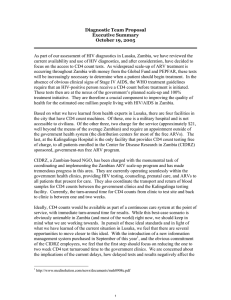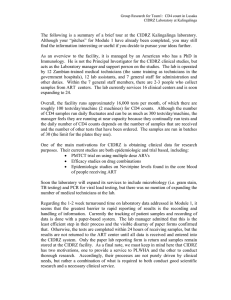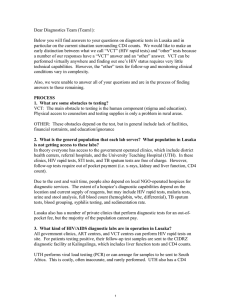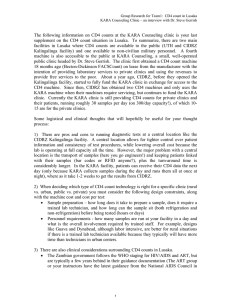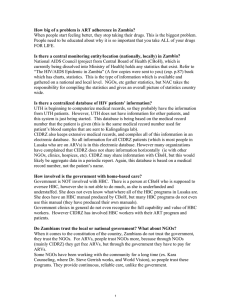Dear Diagnostic Team:
advertisement
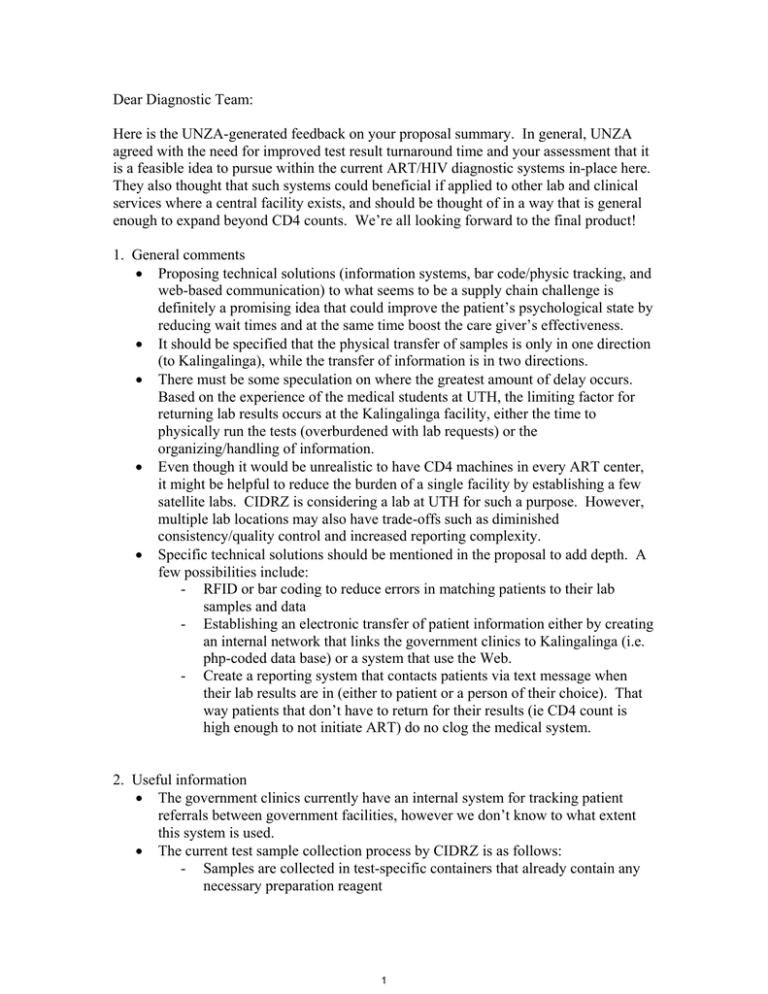
Dear Diagnostic Team: Here is the UNZA-generated feedback on your proposal summary. In general, UNZA agreed with the need for improved test result turnaround time and your assessment that it is a feasible idea to pursue within the current ART/HIV diagnostic systems in-place here. They also thought that such systems could beneficial if applied to other lab and clinical services where a central facility exists, and should be thought of in a way that is general enough to expand beyond CD4 counts. We’re all looking forward to the final product! 1. General comments • Proposing technical solutions (information systems, bar code/physic tracking, and web-based communication) to what seems to be a supply chain challenge is definitely a promising idea that could improve the patient’s psychological state by reducing wait times and at the same time boost the care giver’s effectiveness. • It should be specified that the physical transfer of samples is only in one direction (to Kalingalinga), while the transfer of information is in two directions. • There must be some speculation on where the greatest amount of delay occurs. Based on the experience of the medical students at UTH, the limiting factor for returning lab results occurs at the Kalingalinga facility, either the time to physically run the tests (overburdened with lab requests) or the organizing/handling of information. • Even though it would be unrealistic to have CD4 machines in every ART center, it might be helpful to reduce the burden of a single facility by establishing a few satellite labs. CIDRZ is considering a lab at UTH for such a purpose. However, multiple lab locations may also have trade-offs such as diminished consistency/quality control and increased reporting complexity. • Specific technical solutions should be mentioned in the proposal to add depth. A few possibilities include: - RFID or bar coding to reduce errors in matching patients to their lab samples and data - Establishing an electronic transfer of patient information either by creating an internal network that links the government clinics to Kalingalinga (i.e. php-coded data base) or a system that use the Web. - Create a reporting system that contacts patients via text message when their lab results are in (either to patient or a person of their choice). That way patients that don’t have to return for their results (ie CD4 count is high enough to not initiate ART) do no clog the medical system. 2. Useful information • The government clinics currently have an internal system for tracking patient referrals between government facilities, however we don’t know to what extent this system is used. • The current test sample collection process by CIDRZ is as follows: - Samples are collected in test-specific containers that already contain any necessary preparation reagent 1 - Each collection container has a number associated with it, which is hand written on the lab order form (paper). The lab order form also has some patient information (name, age, sex) and the required test. After the sample is collected, the lab order form is taped to the collection container and placed in a cooler that is later (same day) collected by CIDRZ. The patient’s name is also written on the collection container. This would be a great application of an electronic patient information system for reducing the time of information transfer and reducing errors in reporting lab test results. 3) Why is it important to reduce the turnaround time on CD4 results? • The faster patients receive their test results, the better it is for their psychological state (not anticipating the worst) and the more confidence they will have in their healthcare system • Patients eligible for ART will receive treatment faster • Doctors will have increased efficiency because they will be less burdened with “pending” cases. • People very often come from out of town (up to 500 km) to visit UTH because that is the facility in Zambia where people often have the most confidence. Reducing turnaround time allows this subset of patients to return home faster and increases the likelihood that they will wait for their results. 4) See text-specific comments below Diagnostic Team Proposal Executive Summary October 19, 2005 As part of our assessment of HIV diagnostics in Lusaka, Zambia, we have reviewed the current availability and use of HIV diagnostics, and after consideration, have decided to focus on the access to CD4 count tests. As widespread scale-up of ARV treatment is occurring throughout Zambia with money from the Global Fund and PEPFAR, these tests will be increasingly necessary to determine when a patient should begin treatment. In the absence of obvious clinical signs of Stage IV AIDS, the WHO treatment guidelines require that an HIV-positive person receive a CD4 count before treatment is initiated. These tests then are at the nexus of the government’s planned scale-up and 100% treatment initiative. They are therefore a crucial component to improving the quality of health for the estimated one million people living with HIV/AIDS in Zambia. Based on what we have learned from health experts in Lusaka, there are four facilities in the city that have CD4 count machines. Of these, one is a military hospital and is not accessible to civilians. Of the other three, two charge for the service (approximately $21, 2 well beyond the means of the average Zambian) and require an appointment outside of the government health system (the distribution centers for most of the free ARVs). The last, at the CIDRZ-operated Kalingalinga diagnostic lab is the only facility that provides CD4 count testing free of charge (KARA does too for their non-private clinic patients), to all patients enrolled in the Center for Disease Research in Zambia (CIDRZ) sponsored, government-run free ARV program. CIDRZ, a Zambian-based NGO, has been charged with the monumental task of coordinating and implementing the Zambian ARV scale-up program and has made tremendous progress in this area. They are currently operating in 18 government health clinics, providing HIV testing, counseling, prenatal care, and ARVs to all patients that present for care. They also coordinate the transport and return of blood samples for CD4 counts between the government clinics and the Kalingalinga testing facility. Currently, the turn-around time for CD4 counts from clinic to test site and back to clinic is between one and two weeks. Ideally, CD4 counts would be available as part of a continuous care system at the point of service, with immediate turn-around time for results. While this best-case scenario is obviously untenable in Zambia (and most of the world) right now<actually I don’t even know if this is possible>, we should keep in mind what we are working towards. In pursuit of these ideal standards and in light of what we have learned of the current situation in Lusaka, we feel that there are several opportunities to move closer to this ideal. With the introduction of a new information management system purchased in September of this year1, and the obvious commitment of the CIDRZ employees, we feel that the first step should focus on reducing the one to two week CD4 test turnaround time to the government clinics. We are concerned about the implications of the current delays, how delayed tests and results negatively affect the integrity of the blood samples and the likelihood that the patient will return within an appropriate timeframe to obtain his or her results. Our proposal is to solicit additional, external funding to assist the CIDRZ team enhance their current capacity to perform, read, and transfer samples and information for the CD4 tests. This assistance will come in the form of both human and technological resources, based on a systems assessment and cross-team knowledge sharing. From a humanresources perspective, we will help CIDRZ improve the collection of blood samples, how and when they are transported to Kalingalinga, and reduce any backlog within the current testing system by operating 24-hours a day until the samples coming in that day can be run that night or the following morning. From a technological perspective, we will help CIDRZ implement enhanced tracking tools for blood samples and use new and existing technology to improve the data transfer after the tests have been completed. Ultimately, we hope to reduce the turn-around time to at least one-day. To measure our effectiveness, after a full on-site assessment, we will map out the existing process and current process times. From there, we will identify the opportunities to reduce as many of the delays as possible and implement proposed changes. We will monitor the changes and how they affect the timeline and tweak the processes as necessary to optimize results. 1 http://www.medisolution.com/news/documents/msh0908e.pdf 3 MIT OpenCourseWare http://ocw.mit.edu EC.S11 Engineering Capacity in Community-Based Healthcare Fall 2005 For information about citing these materials or our Terms of Use, visit: http://ocw.mit.edu/terms.
